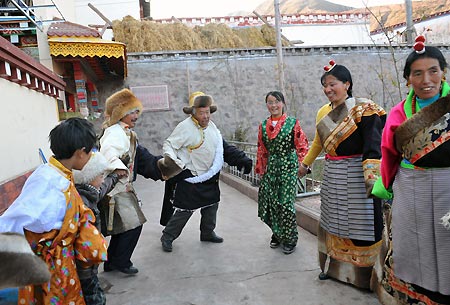|

|
|
Tibetan people in traditional dress celebrate the first Serfs Emancipation Day at home in Qamdo, southwest China's Tibet Autonomous Region, March 28, 2009. [Xinhua]
|
The first Serfs Emancipation Day was celebrated across Tibet Autonomous Region on Saturday, while people from elsewhere in China expressed their wishes to the Tibetans.
CELEBRATION ACROSS TIBET
In Lhasa, readers of the broadsheet Tibet Daily and Tibet Economic Daily found that Saturday's edition of both newspapers became thicker--special issues were published to introduce the changes since democratic reform in 1959.
In the Ngaqen village, fully attired Tibetans gathered in the village club to watch the televised grand celebration held on the square in front of the Potala Palace about 30 kilometers away in the seat of Lhasa.
Tsamjo, 66, who lived in a two-story building, said her life was better than "the landlord in the past".
She had worked as a serf for seven years before the democratic reform. "At that time, our plot of land was smaller than a palm, and our room was as big as the nose of a cow," she said.
After the ceremony, villagers performed traditional Tibetan dances and held a contest of tug-of-war.
In the Tashigang village of Dagze county, more than 1,000 people enjoyed their own party.
"We have prepared for about a month for the party on our own holiday," 19-year-old Degyi said while doing the makeup.
As a young girl, she admitted that she had little knowledge about the past. "But I feel sad whenever listening to my grandparents telling the stories," she said.
|

|
|
Tibetan people in traditional dress celebrate the first Serfs Emancipation Day at home in Qamdo, southwest China's Tibet Autonomous Region, March 28, 2009. [Xinhua]
|
In the Qamdo prefecture in east Tibet, slogans written on red scrolls hailing the Serfs Emancipation Day could be seen on major roads, where sellers in vegetable markets were waiting for their customers, monks in monasteries were chanting sutras and street vendors were soliciting business. Life was as peaceful as ordinary days. In the Tianjin square, dozens of passers-by stopped to watch performances for the holiday.
|

|
|
Tibetan people in traditional dress celebrate the first Serfs Emancipation Day at home in Qamdo, southwest China's Tibet Autonomous Region, March 28, 2009. [Xinhua]
|
In Beijing, Serfs Emancipation Day became the hottest topic among students in the Tibet Middle School. Many students hummed the old song "Freed serfs sing in happiness".
"My grandparents were both serfs," said an eleventh-grader Dawa Dorje.
"They told me that they tied stones to their feet as shoes, and my granny became blind because she had no money to cure her eye illness," she said.
Currently there are 810 Tibetan students in the school, whose accommodation, clothes, health care were all funded by the government.
Main celebration for the holiday was held on the square in front of the Potala Palace in Lhasa, capital city of Tibet, at 10 a.m.
The gathering was presided over in both Tibetan and Mandarin by Qiangba Puncog, chairman of the regional government of Tibet, who was dressed in a traditional Tibetan robe. It was attended by about 13,280 people.
After the national flag was hoisted against the backdrop of the grand Potala Palace and snow-capped mountains in the distance, representatives of former serfs, soldiers from the People's Liberation Army (PLA) and students delivered speeches.
Tibet's Communist Party chief Zhang Qingli was the last to speak.
"Burying feudal serfdom and liberating the one million serfs in Tibet was a natural development in history ... a milestone in the worldwide campaign to abolish slavery, a sign of progress in human rights," he said.
"Tibet belongs to China, not the a few separatists or the international forces against China. Any conspiracy attempting to separate the region from China is doomed to failure. The sky in Tibet will forever be blue, and the national flag will flutter high," he noted.
The ceremony lasted for more than an hour.